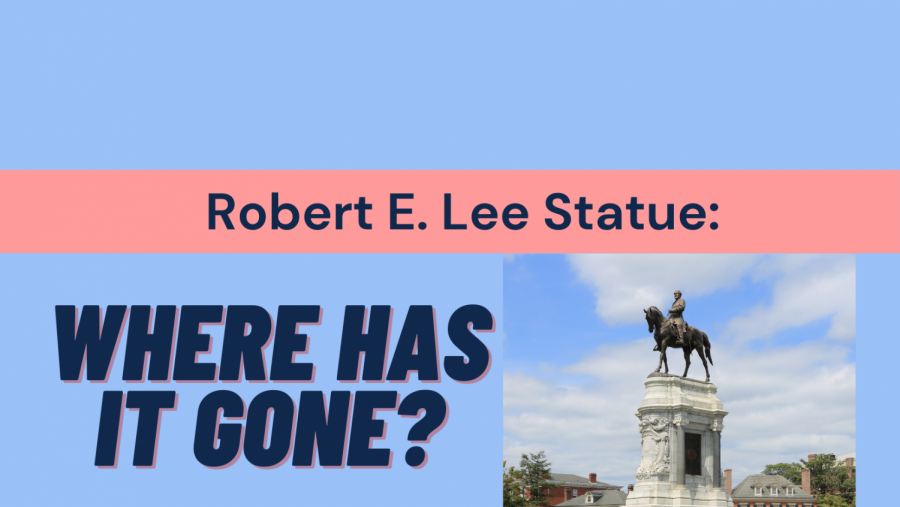Robert E. Lee Statue: Where Has It Gone?
September 21, 2021
A statue of Robert E. Lee, an American general, was removed from where it once stood in Richmond, VA.
On September 8, the Robert E. Lee statue on Monument Avenue in Richmond, Virginia was taken down by the Commonwealth of Virginia following a state Supreme Court ruling. Monument Avenue is known for its statues of Confederate leaders such as Jefferson Davis, Stonewall Jackson, Matthew Fontaine Maury, J. E. B. Stuart, and Robert E. Lee. Among these monuments, Robert E. Lee’s statue was the first and the largest, unveiled on May 29, 1890. With its recent removal, Lee’s statue marks the end of the Confederate statue era on Monument Avenue.
Of these five statues, the Jefferson Davis statue was taken down the earliest on June 10, 2020. The memorial and monument were unveiled in 1907 and built on the former location of Star Fort, a bastion fort in the shape of a star that protected the innermost part of the city of Richmond. Next came the Stonewall Jackson Monument. This monument was built in 1919 and was an equestrian statue of the Confederate general. The memorial was taken down on July 1, 2020, by Mayor Stoney of Richmond. The next monument to be taken down was the statue of Matthew Fontaine Maury. The statue depicted Maury sitting down in front of a large group of people while holding up a globe. The statue was removed on July 2, 2020. The J. E. B. Stuart monument was the next in line to be taken down. It depicted Stuart sitting atop a bronze horse statue. J. E. B. Stuart was a major general and cavalry commander for the Confederate army. This statue was later taken down on July 7, 2020. All of these statues were taken down after the death of George Floyd on May 25, 2020, and the rampant BLM protests which followed.
The last statue to be taken down was the Robert E. Lee monument, just over a week ago. However, the removal of the Robert E. Lee statue happened a year after the rest. So why did it take the state of Virginia so long to take down this statue? To start, in June of 2020, Governor Ralph Northam had announced plans to remove the statue, but he was met by many legal oppositions that claimed that an 1890 deed and the 1889 General Assembly joint resolution forbade him from leading the removal. Furthermore, the residents had also claimed property rights, insisting Virginia should keep the statue. The other four statues had been on Richmond’s city land, meaning that it was the city’s choice to take it down. The Robert E. Lee statue was on state-owned land, which meant that the removal of the statue had to be approved by the Virginia Supreme Court. After 15months of waiting, the Virginia Supreme Court eventually disagreed with the plaintiffs and sided with Gov. Northam. As the statue was just about to be taken down, a construction worker was seen holding up his fingers and counting down from three. On zero, the statue was lifted from its pedestal and the crowd cheered, “Hey, hey, hey, goodbye!” With the final movements of the crane lifting the statue, its 131-year reign came to an end.
So what made these statues so controversial that they were removed? As Ms. Colleary, an art historian and teacher at SHS, argues that the most problematic part about the statues on Monument Avenue was that they “were erected for the purpose of celebrating and perpetuating a culture of white supremacy, and for that reason, they needed to be removed.” After the abolishment of slavery after the Civil War, Jim Crow Laws were put into effect across the United States which legalized and justified the racial segregation of Black people in America. While there doesn’t seem to be an immediate connection, the Jim Crow laws heavily influenced the creation of many Confederate statues across the US. When asked why these statues were put up, Colleary explained that their purpose was to “strike fear and terror” into African Americans and tell them that despite slavery being abolished, they were not equals. Furthermore, many Confederate statues were put up in the late 1800s and early 1900s, almost 50 years after the Civil War ended, and many of them were erected in states that were not even part of the Confederacy. The Confederacy only had 11 states, but Confederate statues were put up in 38 states total— meaning that 27 states, which were never part of the Confederacy, had constructed such statues as an act to suppress African Americans.
The significance held in many of these monuments was not only offensive in how they commemorated notable Confederate or slave-owning figures, but also in the way that these people were portrayed. Three of the five monuments which were taken down were equestrian statues. Historically, equestrian monuments can be dated back to Ancient Roman statues of emperors at around 181 AD. As time passed, equestrian statues became increasingly popular for honoring leaders and nobles, and many other equestrian statues followed this trend, such as the Robert E. Lee, Stonewall Jackson, and J. E. B. Stuart monuments. In today’s society, however, honoring those Confederate leaders is unacceptable and goes directly against the American ideals of “Life, Liberty and the pursuit of Happiness.” Especially in such a “politically volatile time period”, as Colleary states, “the existence of these statues give a platform for white supremacy to still convey their ideas of superiority.” Before its removal, the Robert E. Lee statue was a common rallying point for white supremacists groups such as the KKK and neo-Nazis. Removing these statues means the removal of a platform for spreading white supremacist ideals and making amends to America’s racist history.
Many wonder what would happen with these five statues along with the other 109 Confederate statues that were taken down. With many theories being spread across the internet, many believe that they are being held in undisclosed locations and waiting to be repurposed. Colleary believes that these statues are being kept in private to “prevent riots and uprisings” due to their controversial symbolism. She expects that these statues might eventually be displayed in a “park for banished statues” where people can still learn about them without “erasing history.”
However, the story of controversial statues does not start and end with the Confederate monuments. Today’s society has expanded its perspective of race and equality and many other statues are under fire for being offensive. Even American heroes like Abraham Lincoln and Theodore Roosevelt are being targeted in certain monuments and statues. A monument called the Emancipation Memorial depicts Abraham Lincoln standing above an African American slave who is kneeling on the ground. At first, it seems as if Abraham Lincoln is above the slave and the slave is bowing down to him in fear. Looking closer, the slave can be seen having his hands unshackled and in a stance as if he were to rise up with the help of Abraham Lincoln. Many find this statue extremely offensive and have argued about taking it down. Indeed without noticing some smaller details, it is easy to believe that this statue is offensive. However, one fact is often overlooked about this monument. The Emancipation Memorial was commissioned by the very slaves that Abraham Lincoln freed in honor of his influence and effect on the abolishment of slavery. To the layman’s observation and knowledge, this statue would undoubtedly be offensive. “Who are we to take down the statue when it was commissioned by the slaves [Lincoln] freed?” Colleary posited. Similarly, the Theodore Roosevelt statue that sits in front of the American Museum of Natural History was under criticism. The equestrian statue depicts Roosevelt on a horse being followed by a Native American on his right and an African man on his left, both carrying his weapons. The statue was originally made to honor his influence in Africa and his preservation of Native American territories. However, the statue itself does not do justice to this message as both the Native American and African men are placed behind Roosevelt, making them seem inferior. Also, the height of the horse is significantly taller than the two men, which makes them seem inferior to the horse. If the two men, for example, were placed in front of the horse, it would appear as if they were leading Roosevelt and his horse, making the statue more acceptable. Despite having a message that honors Roosevelt’s relations with Native Americans and Africans, the statue unintentionally creates a racial dynamic that is problematic and led to the New York City Public Design Commission’s unanimous vote to remove the statue.
With the removal of controversial statues all across America, their pedestals lay bare, covered in graffiti supporting the Black Lives Matter movement. Before it was taken down, the Robert E. Lee statue and pedestal were painted over and made into a Black Lives Matter memorial. One artist also projected several BLM images consisting of George Floyd, Breonna Taylor, Harriet Tubman, and many phrases such as “No America Without Black America” and “No Justice, No Peace.” Taking down the Robert E. Lee statue is a monumental step towards alleviating the pain of those whose ancestors were affected by Confederate rule. By removing these statues, many, including Colleary, believe that this is an “emphatic expression of support for the BLM movement.”


